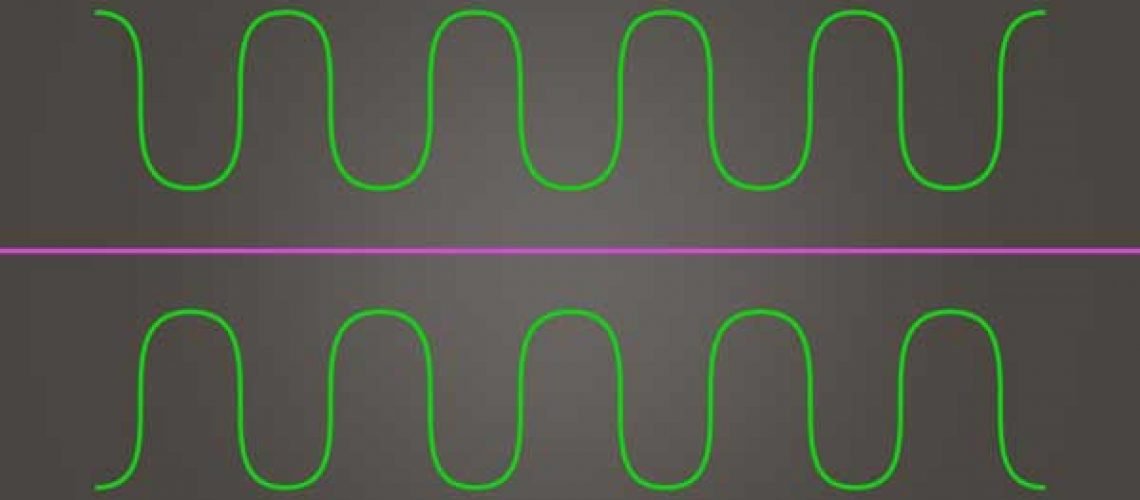The term “phase cancellation” makes most audio engineer’s skin crawl, and will almost always prompt a Guitar Center employee, with a bald head and goatee, to mutter something about mono compatibility. Phase cancellation that results from summing a track into mono will produce a less impactful song. However, we’ll be taking a look at how you can use phase cancellation to your advantage while mixing your music.
Mono compatibility simply means that the stereo version of a song will also play back well in mono. The mono version of a song is never going to sound the same as the stereo version because you lose the width created by differences between the left and right channel when you sum a song to mono. In this way, the mono version and stereo version of a song provide two very different listening experiences.
Attempting to make the mono and stereo version of your song sound the same is pointless, so why not realize each version for what it is, and maximize their potential individually? This may even mean taking each version of your mix in a drastically different direction.
Phase cancellation mixing techniques will cause your mono mix to sound much different than your stereo mix, but that’s okay! If you accommodate for the differences, and you’re happy with how your mix sounds in stereo and mono, you’ve achieved mono compatibility.
Want a quick refresher on how phase cancellation works? Learn about the basics of phase cancellation here.
Set Mono and Stereo Levels Separately
One the most common side effects of partial phase cancellation is that similar elements panned out to the sides of your mix, that are out of phase with one another, will see a reduction in energy when summed to mono.
If you attempt to duplicate a vocal, pan the original hard left, and the duplicate hard right, you’ll hear that it sounds as though the vocal is in mono and not stereo. What’s missing is a timing difference between the left and right channel. This timing difference is what will allow you to perceive stereo width.
The more you delay one of the channels, the further you push it out of phase with its duplicate. When auditioning your mix in stereo, your primary concern is achieving width, but when auditioning your mix in mono, you’re able to hear the severity of phase cancellation, and loss of energy, as you delay the track. The further out of phase the two signals are, the more of a level reduction you’ll here.
Partial phase cancellation causes a reduction in signal level, but when is it appropriate to apply this to a mix? Many modern pop and EDM mixes aim to achieve an extremely wide stereo image, positioning main elements in the center of the mix and primary supporting elements out to the sides.
For example, you may have a vocal panned to the center of your stereo image, and some super saws panned out to the sides. It’s quite common for the side elements to be set similar in level to the center element; this will allow you to create an overall louder stereo master. The problem is that when you sum a mix like this into mono, the supersaws may potentially overwhelm the vocal.
If you’re willing to tweak the stereo width of the supersaws slightly, you can adjust their level when the track sums to mono by making use of partial phase cancellation. To do this, audition your mix in mono, and adjust the delay time of one of your supersaws. When it sounds like they’re sitting behind your main vocal, leave the track delay alone. You should end up with supersaws that sound wide in mono, and then reduce in level to sit behind the main vocal when you sum the track to mono.
Create Ultra-Wide Stereo Sounds That Are Mono Compatible
Creating ultra-wide stereo effects can be achieved using phase inversion, but it comes at a price. If you attempt to create stereo width by duplicating a sound, panning each track hard left and right, and then phase inverting one of the tracks, the result will sound extremely wide in stereo, but the two sounds will vanish in mono.
Silence isn’t the end of the world, as long as you account for it. For example, if you use phase inversion to create super wide backup vocals in stereo, you should stick an extra backup vocal in the center of your stereo image that sits just behind the lead vocal. The backup vocals panned out to the sides will disappear in mono, but the quiet backup vocal panned to the centre will remain present.
Mono compatibility can be achieved in many different ways, and doesn’t necessarily need to include all the original elements of your stereo mix. Phase cancellation will always result in a loss of audio material, but if you understand what’s happening and how phase cancellation works, you can make up for that loss.
If you record acoustic guitar, check out The Mid-Side Recording Technique section of “The Ultimate Guide to Recording Acoustic Guitar” for a further look at phase cancelation being used as a mixing tool.
Make sure to follow Black Ghost Audio on Facebook, Twitter, Instagram, and YouTube to stay up to date on the latest music production tips and tricks. There’s new content every week, and I don’t want you to miss out.




